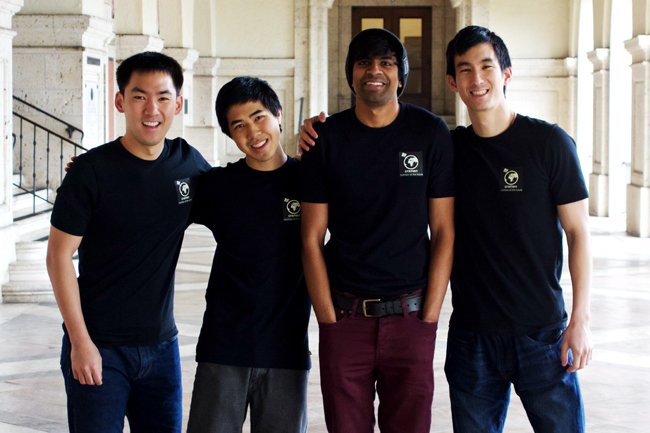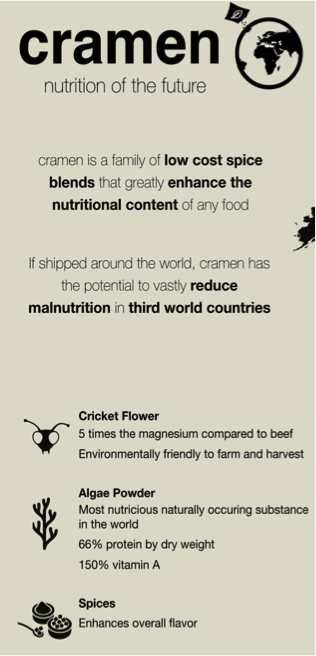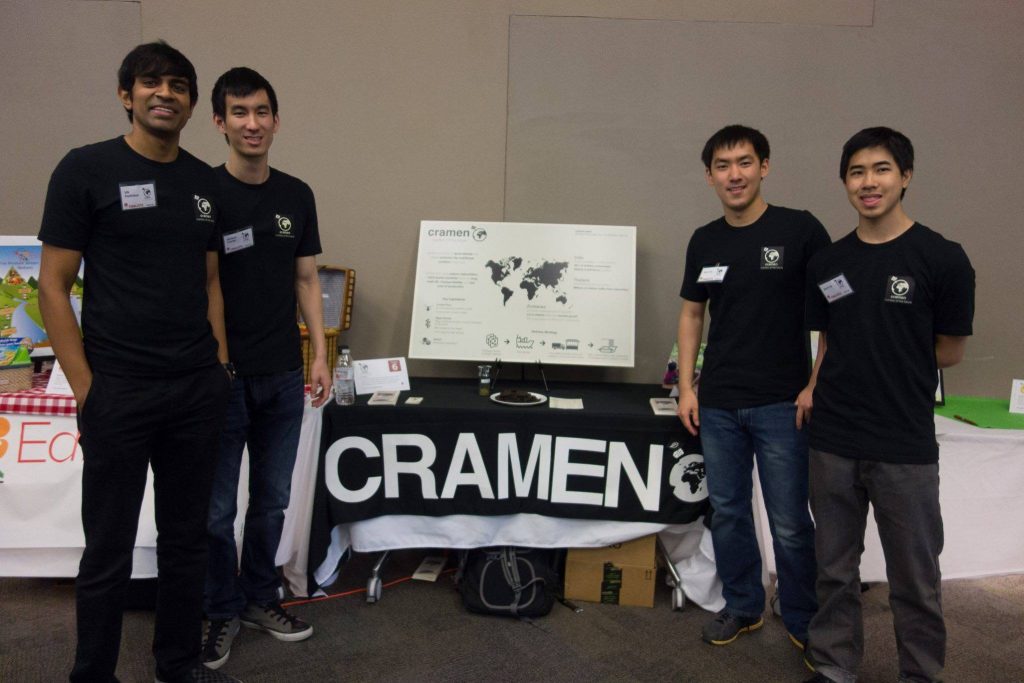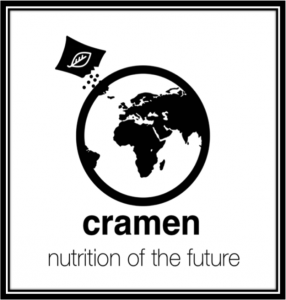
Interview by Helen Yuan
These four guys think so. Meet Michael, Gary, Kevin and Vik, students from the University of Texas utilizing their tech and engineering backgrounds to solve world hunger using some surprising ingredients– crickets and algae. Cramen (a play on crickets + Ramen) was born after a brain-storming session for a food lab competition at UT. But what started as an idea for a competition could be something that impacts the lives of millions.

Tell me more more about the inspiration behind Cramen.
We initially got started when we heard about a food lab competition our University was hosting. After brainstorming some ideas, we drew up and cooked up some ideas on nutritious foods with low cost of production and distribution. After placing within the top 10 finalists at the competition, we felt validated and are currently working on next steps to get the prototype into test markets.
In terms of inspiration, our team was really taken aback when we did research and discovered how much malnutrition a huge swath of the global population suffers from. Malnutrition is a huge factor limiting impoverished families and we felt this was potentially our way of making the world a better place.
One of us (Gary) had the opportunity to visit Cambodia during a study abroad program and was faced with malnutrition at its worst in both adults and kids. It really changed how he perceived hunger and motivated him to work towards a solution.
Why crickets and algae?
Since healthy eating and natural foods are becoming increasingly popular, we felt that developing spice blend containing cricket and algae powder would be both an economical and nutritious solution to reducing malnutrition in countries like Thailand, Africa, and India. From a cultivation perspective, raising crickets require less land and money than raising cows and chickens. Similarly, raising spirulina algae can be cultivated in small tanks, implying that less land is required for agriculture. Additionally, cricket powder is known to be rich protein and iron while spirulina algae powder is rich in numerous vitamins. Hopefully, our highly nutritious spice blends can help promise a healthier future for malnourished populations.

How did you go about developing Cramen’s different spice blends?
Developing different spice blends involves both a systematic work flow model and trial and error. In the first stage, we interview customers about their preferences for spice blends, which essentially allow us to develop customer requirements. In the second stage, if the customer’s requirements are feasible, we will then propose a budget for the project. In the third stage, we begin purchasing spices. In the fourth stage, we begin experimenting with mixing spices with different amounts of cricket and algae powder. Additionally, one person is documenting every step of experiment, and another person is developing dough; spice blends are generally eaten with another meal. In the fifth stage, we combine the dough with the spice blends and begin baking. In the sixth stage, we taste the baked good ourselves and document the taste of baked good. In other words, a good taste implies success while a bad taste implies that we should either scrap the recipe or try to modify the ingredients. For us to be successful, we will need to also test our product on consumers and use any consumer feedback to improve the product.
How open are people to trying your cricket-based spice blends? Do you think the fact that they are made from insects scare most people away?
There is surely a stigma against crickets, especially in the US. During the food lab competition, many people were hesitant when we offered some sample cricket infused cookies. Once they ate it and realized there wasn’t any particular taste difference, they were much more open to it. Some ideas behind removing the stigma are giving out free samples or initially entering the market with low cricket blends and then ramping up in the future. The stigma against crickets seems to be primarily in developed countries. In more impoverished countries, the stigma is less severe.
Internally, we have had debates whether to market our spice as having crickets (as opposed to just mentioning it in the ingredient list). We feel that crickets are a good differentiator in the spice market and will create a higher rate of adoption.
How do you manage a start-up company on top of being full-time students?
The key is time management and communication with each other. All of us did our homework and studying during the weekdays. During the weekends, we scheduled time to work on Cramen.
What’s the biggest challenge you’ve faced so far?
The biggest challenge by far is having the team juggle both Cramen and school. Finding time where we can all meet has been a recurring issue, but we work around it with using GroupMe and having all of our documents synced via Google Drive.
Managing a business can’t always be done over the phone or via texts, so we try our best to all meet up whenever we have to make major decisions.
What’s your biggest accomplishment?
Forming Cramen has taught us how to start a business and work as a team. We’ve learned how important it is for us to be open to discussion, ambiguity, disagreement, new ideas, and even negative feedback. We learned that we have to be prepared to satisfy customer requirements, adhere to regulations and safety standards, and even defend our business plan when presenting in front of judges, food critics, and food bloggers. Overall, we believe that these new experiences will help us in our careers and taking Cramen further.
What’s currently in the works, and what future plans do you have for your business?
We have been following up with very interested folks we met during the Food Lab Challenge. We met so many fans!! As of now, our team is planning to improve the spice blend and develop relationships with other contacts. At the finals, we met other cricket-based companies (Hopper and Aspire) who were interested in having some sort of monthly meeting to discuss our foray in cricket-based food products. Aspire currently manufactures cricket flour from Mexico, Ghana, and the US. Hopper makes most granola crunches that are targeted to the US. This information helped us understand where we are in the market, since we hope to target malnourished populations (both in the US and abroad).
Do you have any advice for aspiring entrepreneurs?
Our main advice is two-fold: to always persevere and to know when to let go. When you have a vision in mind, there are going to be obstacles. One of the greatest challenges is not actually coming  up with the idea, but having the resources and team passion to implement it. At the same time, always do a fact-check every couple of months or so to determine if your strategy and product are worth continuing.
up with the idea, but having the resources and team passion to implement it. At the same time, always do a fact-check every couple of months or so to determine if your strategy and product are worth continuing.
For more about Cramen, check out their recent feature in The University of Texas newspaper.
If you have any further ideas or would like to partner with Cramen to help people in malnourished countries, please contact them at team.cramen@gmail.com or 281-838-2294.
